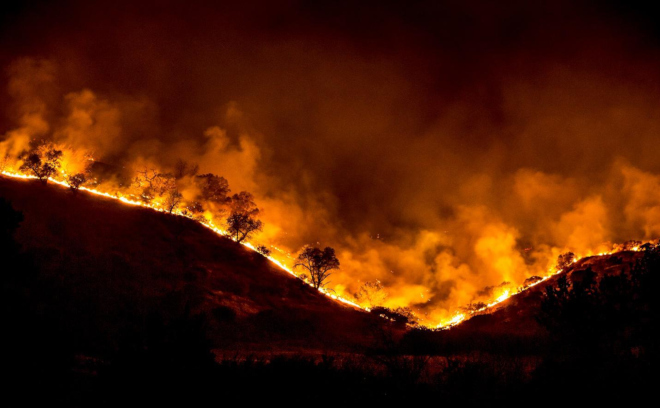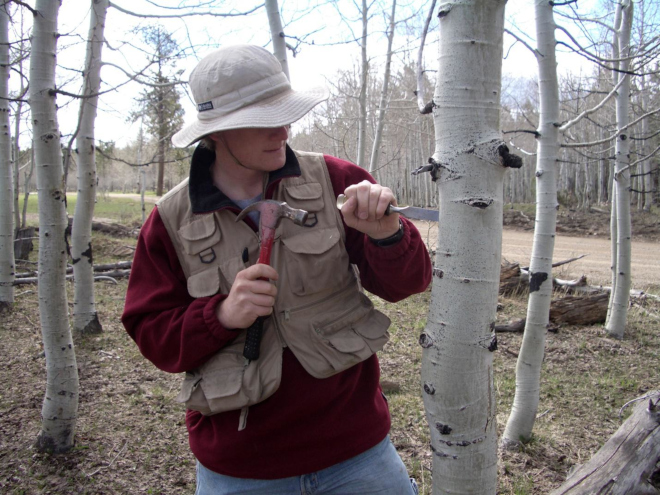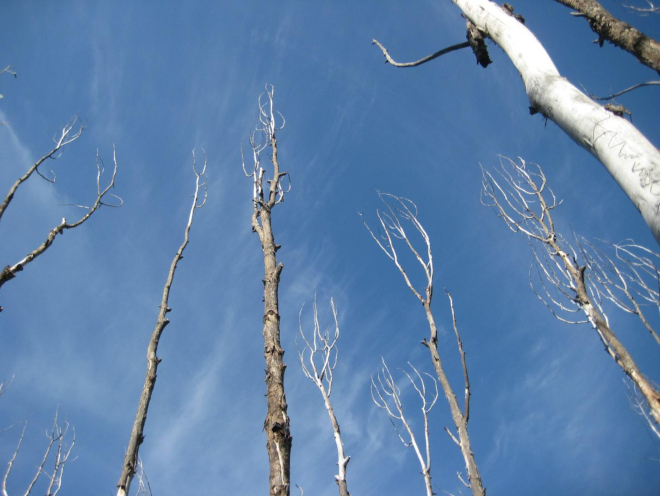
2018 Woolsey Fire, California Credit: Wikimedia
The images of recent forest fires in Australia and California seemingly portend climate doom, but fire is a natural and important ecological process for many ecosystems around the world. It plays a crucial role for many plant species, helping plants to regenerate and re-sprout, as well as to induce nutrient and carbon cycling. However, those pictures aren't that far off—climate change is indeed increasing and supercharging wildfires throughout the world, turning this natural process from rejuvenating to ruinous.
We recently interviewed Dr. Bill Anderegg, Assistant Professor at The University of Utah and 2016 Blavatnik Regional Awards for Young Scientists Winner. Dr. Anderegg's research is on tree physiology—the study of how trees function to grow and survive—and how climate change is impacting tree physiology and the frequency and nature of wildfires. This interview has been condensed and edited for clarity.
A lot of your research is at the intersection of climate change and tree physiology. Can you give some background on the effects of climate change on tree physiology and how those effects influence these very large new forest fires?
On the one hand, rising carbon dioxide (CO2) concentrations generally help tree physiology. Plants pick up more carbon and in some cases grow more, but on the other hand, there are stresses that come with climate change—particularly rising temperatures and droughts—as well as an increase in pests and pathogens which can really harm tree physiology.
Our research is trying to understand this fundamental tug of war between the benefits of CO2 and the negative stresses of climate change: which of these different forces are going to win out, and what does this mean for the future of Earth's forests? In some of our global models of forests right now, there are some scenarios in which the benefits win out and you generally see a greener set of ecosystems by the end of the century. In other situations, the damage of temperature and droughts and pests and fires win out and you see large scale loss of forests and a much browner world by the end of this century.

Dr. Bill Andregg in the field
With the recent fires in Australia and California, how exactly is climate change fueling their severity and size?
For forest fires there is this triangle whereby fire behavior after an ignition is influenced by fuel, fire weather, and topography. Climate change in particular strongly affects the first two legs of that triangle. Warming temperatures and dry conditions really dry down fuels and make these ecosystems ready to burn massively. That's absolutely what you saw in Australia and California. The other major contributing impact is on fire weather. Hotter and drier temperatures, less humidity in the air, and higher winds are what tend to make these fires go “mega.” Over the past 30 years, fire seasons have lengthened by about one to two months in the Western US. So, we're now getting fires burning in November when that was not previously the case.

Credit: Oregon State University Extension Catalog
As you said, wildfires are really important, but when it comes to these intense forest fires what are the short-term and long-term effects?
Climate change can change the fire behavior. Our usual national fire regimes had very frequent fires, but at very low intensity, which usually means the fires would come through and burn the grass and the shrubs underneath mature forests but not actually kill the tall, mature trees. These fairly low intensity fires that clean out some of the grasses and the understory are beneficial in the short-term and long-term.
What we're unfortunately seeing in California and Australia, and really across the Western US, is that with drier fuels and more intense fire conditions we tend to get what we call “canopy fires”, which means that the fire is burning everything in the forest, including the mature trees. Unfortunately, the short- and long-term effects are both quite negative. It takes forests a long time to recover, regrow, and reestablish species. In the meantime, you also lose a lot of the carbon stored on the landscape and find an increased risk of soil erosion.
Is there any way to mitigate the intensity or the repercussions of these large forest fires?
Slowing down the speed of climate change is one of the best ways to prevent these mega-fires. There are also local and regional steps that we can take. You can be proactive in your forest management. By reducing the fuels and controlling ignition sources you really decrease the risk that a mega-fire breaks out.
A lot of these proactive measures of fire management and fire mitigation are often incredibly cost-effective. The U.S. Forest Service is one of the main agencies that we would like to do this, but every year their budget just disappears down the drain due to the actual fighting of fires. However, every dollar you can spend making forests more resilient and less prone to these mega-fires would absolutely save money down the road in fighting fires.
What does the future of forestry management look like in the face of climate change?
We're now launching an effort to develop risk maps of climate's impacts on forests. We want to come up with maps of where drought, fire, insects and pathogens might be really bad for forests. We think these maps are going to be a powerful tool for a lot of stakeholders. You might want this information when considering forest and animal conservation strategies as well as for forest carbon projects that are trying to grow forests to take carbon out of the atmosphere.
There was a recent study that estimated how much climate change is affecting wildfires in the Western US, and their conclusion was that about half of the area burned in the Western US over the past 30 years was due to climate change. So, one out of every two acres burned was due to climate change, rather than natural fire processes. This demonstrates the scope of how much climate change really matters.

Forest experiencing drought. Credit: William R. L. Anderegg, Ph.D.